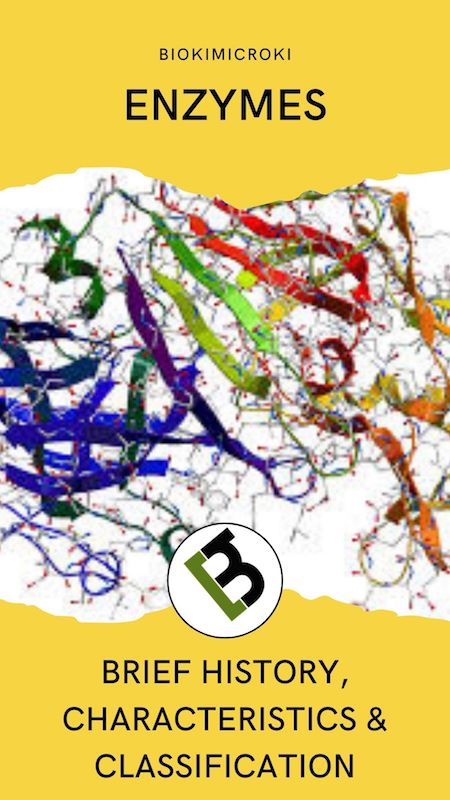‘Enzymes are responsible for Chemistry of life’
Introduction to Enzymes –
The living cells are actively involved in synthesizing required biomolecules and degrading waste. This is achieved by numerous and complex metabolic pathways. The metabolic pathways are regulated and monitored by enzymes hence they are called catalysts. The metabolic pathways are a series of chemical reactions occurring within the cell. The enzymes can increase or decrease the rate of metabolic reactions. They can regulate the reactions in both the direction – forward and reverse. Catalytic capabilities of enzymes make them play a crucial role in sustaining life. In presence of oxygen, aerobic living organisms produces energy by the oxidation of the ingested sugar. During oxidation of sugar, carbon dioxide, water and energy is released. The released energy is used for various physical, mental and molecular activities. The oxidation process is carried out by set of enzymes, providing us energy in timely manner. Without enzymes, the living cells would never been able to extract energy and hence there would have been no life.
The catalyst power of enzymes are similar to synthetic or inorganic catalyst used in organic chemistry. In fact, the biological enzymes have much more superior catalytic power than the artificial ones. Chemically, the enzymes are proteins in nature (few RNA also acts as enzymes called ribozymes). The protein form of enzymes are polypeptide chain/s which folds 3 dimensionally and form active structure. The length of the linear chain varies and hence the size. Compared to the enzyme size, the substrate are very small.
As a life science learner, we need to study enzymes in order to understand how the enzymes regulate metabolic pathways and how their concentration or absence cause any disease. They are also studied for increasing production of in-vitro biological industrially important products. Hence, measuring enzymes and their activities has both medical and Industrial applications.
Brief History on discovery of Enzymes –
- In 1700 century, the biological scientist initiated the study of stomach secretion to understand its role in digestion.
- In 1850s, Louis Pasteur studied fermentation of beer and found that yeasts has something in it which converts sugar into alcohol. He named the unknown thing as ‘ferments’. According to Louis Pasteur, that we cannot separate those ferments from yeasts.
- In 1897, Eduard Buchner break open the yeasts cells releasing the yeast extract. He showed that yeast extract can also ferment sugar to alcohol. Hence, he successfully separated the ‘ferments’ from the yeasts proving that fermentation can also be carried out even when after separating ferments from the cells, hence disapproving the concept postulated by Louis Pasteur. Eduard Buchner has received the Nobel Prize for discovering cell free fermentation.
- Frederick Kunhe named these molecules as enzymes. Discovery of enzymes and its role in the sustaining life opened the new branch of Life Science called Biochemistry.
- James Sumner, and John Northrop and Moses Kunitz crystallized urease, pepsin and trypsin respectively. The crystallization of enzymes found that chemically they are proteins. It was Haldance who postulated catalytic ability of enzymes. He suggested that enzyme interacts with its substrate with weak and non covalent bonds forming the product. This is the fundamental principle of enzymology till date.
Characteristics of Enzymes –
- Chemically by nature most of the enzymes are proteins and few are RNA.
- Enzymes catalyze the reactions without getting consumed or changed, hence they are reusable.
- The molecular mechanism of increasing the rate of reaction is by decreasing the activation energy of that particular chemical reaction. This is achieved by binding of enzyme to substrate forming enzyme-substrate complex.
- The site at which the substrate binds to the enzyme is called ‘site‘. The enzyme converts the substrate into product.
- The unique characteristic of enzymes is that they are specific to substrate. They are also stereo-specific.
- The efficiency of enzymes is affected by temperature, pH, substrate and enzyme concentration.
- The required optimum conditions varies from enzyme to enzyme.
- The enzymes get denatured in extreme environment
- The enzymes are regulated by binding of other proteins or small molecules, or by modifying their side chains.
- The enzymes get degraded or denatured in extreme environment.
Nomenclature of Enzymes –
The discovery of enzymes occurred across the globe and scientist were naming them inconsistently. This was leading in creating confusion in conducting the research. To resolve this, International Commission on Enzymes was established. They set some some rules for naming the enzymes. While naming, it was asked to consider the name of the substrate, type of reaction they catalyze and their name should end with ‘ase’. For example, Succinate dehydrogenase, where succinate is the substrate, the enzyme catalyses dehydrogenation reaction and the name ends with ‘ase’.
Classification of Enzymes –
The further ambiguity was the classification of enzymes and this was introduced by International Union of Biochemistry (IUB) in 1961. The enzymes are majorly classified into six categories based on the type of chemical reaction they catalyzed. The six categories were further classified based on parameters like chemical nature of enzyme, chemical nature of its substrate, and prosthetic group.
The enzymes have also been allotted with a number called Enzyme Commission number (EC number). The scheme of Enzyme Commission (EC) number is based on the type of reaction catalyzed by enzyme. The significance of the EC number is similar to the roll number of students where the roll number helps the teacher and administrator to identify the student’s name, semester and department. Similarly, the Enzyme Commission (EC) number assist us to identify the enzyme and its function. It also assist to distinguish the enzymes from one another. The EC numbers are allotted by Nomenclature Committee of the International Union of Biochemistry and Molecular Biology.
The EC number of an enzyme consist of 4 digits. For example – 1.2.3.4
where 1 represent class, 2 is subclass, 3 is the sub subclass and 4 is the sub sub subclass. There are six major classes and these are explained in the following text. subclass and sub sub class describe the chemical reaction catalysed by the enzyme and the sub sub subclass allows the distinguish between the enzymes belonging to the same subclass.
The Committee has categorized the enzymes into following six categories or classes-
- Oxidoreductases
- Transferases
- Hydrolases
- Lyases
- Isomerase
- Ligase
(While studying, I always used to face difficulties in remembering their sequence so I used a trick and made an acronym as Over The HILL (O -Oxidoreductases, T– Transferases, H-Hydrolases, L-lyases, I– Isomerases, L-ligases. As the ;L’ is repeated, it may create confusion if Lyases is first or ligases. To overcome this confusion, I again used another trick and where I remembered breaking (lyases) is followed by joining (ligases). I hope my trick would be useful for you too).
Let’s first understand each class –
1. Oxidoreductase –
The name itself indicate that its function is related to oxidation and reduction. They are designated as E.C.1This class of enzymes catalyses oxidation and reduction reactions. In oxidation-reduction reactions the electrons are transferred from donor to acceptor.
AH + B → A + BH (reduced)
A + O → AO (oxidized)
The substrate that is oxidized is regarded as hydrogen donor and the substrate that is reduced is regarded as hydrogen acceptor. For example Dehydrogenase remove the hydrogen from substrate and reductase add the hydrogen. Oxidase is specifically used for oxygen is the electron acceptor.
2. Transferases –
The second class is transferases, hence, they are designated as E.C.2. These enzymes are involved in the catalyzing the transfer of chemical group from a donor to the acceptor molecule. T The most common examples of this class are Polymerases, Methylase, and Kinase.
AX + B = A + BX
he further classification of this class is based on the type of chemical molecule it is transferring. E.C.2.1 transfers single carbon molecule whereas E.C.2.2 transfers aldehyde or ketonic group.
3. Hydrolases –
This is the third class of enzyme, they are designated as E.C.3. This class of enzymes are involved in the breaking the bonds with the help of water. Most of the digestive enzymes like pepsin, urease, and glycosidase fall in this class. Their name indicate the type of bond they are breaking.
AB + H2O = AH +BOH
4. Lyases –
This is the fourth class consisting of all those enzymes that catalyses breaking of covalent bonds without using water. They are designated as E.C.4. Few common examples are ketoses, aldoses, and histidase.
AB + XY = AX-BY
5. Isomerases –
This is the fifth class of enzyme and they are designated as E.C.5. They are involved in inter-converting the isomers (geometrical, positional and optical) by changing the spatial arrangement within the molecule. The common examples are racemase, isomerase, and epimerase.
A=B
6. Ligases –
This is the sixth class of enzymes that are involved in the joining of two molecules. They are designated as E.C.6. They are involved in the formation of covalent bonds like C-C, C-N, C-S, C-O. In order to form bond or join molecules, the enzymes need energy in the form of ATP (NTP – Nucleotide Tri Phosphate).
A+B+NTP = AB +NDP +P
A+B+NTP = AB + NMP+PP
Activity –
https://www.enzyme-database.org/
This is an official website for exploring the Enzyme Commission Number. This website has been officially approved by nternational Union of Biochemistry (IUBMB) Enzyme nomenclature and classification list. This website was developed in 2005 at Trinity College Dublin.
Using this official website, search the enzyme names and their type of catalysis for the following EC numbers –
- E.C.1.1.1.1
2. E.C.1.1.2.2
3. E.C. 3.3.1.2
4. E.C.1.2.5.1
4. E.C.1.3.1.1
5. E.C.2.1.1.1
6. E.C.5.1.1.2
7. E.C.2.1.1.2
8. E.C. 6.1.1.2
9. E.C.4.2.1.2.
10. E.C. 2.2.1.2
Further Reading –
- MLA. Nelson, David L. (David Lee), 1942-. Lehninger Principles of Biochemistry. New York :W.H. Freeman, 2005.
- Murray. “Biochemistry & Medicine.” Harper’s Illustrated Biochemistry, 31e Rodwell VW, Bender DA, Botham KM, Kennelly PJ, Weil P. Rodwell V.W., & Bender D.A., & Botham K.M., & Kennelly P.J., & Weil P(Eds.),Eds.
- Stryer, (1995) Biochemistry. 4th Edition, W. H. Freeman and Company, New York.
Dr. Sangha Bijekar has 9 years of Teaching Experience at University level. She loves to get engage in teaching and learning process. She is into blogging from last two years. She intends to provide student friendly reading material. She is avid Dog Lover and animal rescuer. She is learned Bharatnatyam and Katthak Dancer. She is into biking and She also loves to cook.


